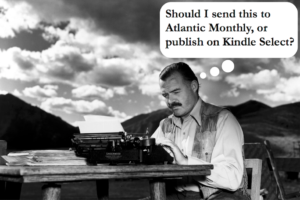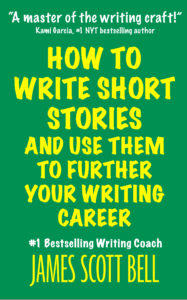by James Scott Bell
@jamesscottbell
 If I may indulge in a little horn toot today. My latest release has dropped—just don’t drop it on your foot. Because the print version comes in at a honkin’ 612 pages (173k words). It looks nice on a shelf but will also work as an emergency doorstop. It sells for $28.95.
If I may indulge in a little horn toot today. My latest release has dropped—just don’t drop it on your foot. Because the print version comes in at a honkin’ 612 pages (173k words). It looks nice on a shelf but will also work as an emergency doorstop. It sells for $28.95.
The ebook is considerably lighter, and is a “steal” at the special launch price of just $3.49. You might want to hop on that, as the price goes up to $6.99 in a few days.
Down These Streets is a complete collection of my short stories. From the introduction:
I’ve always considered short stories the hardest kind of fiction to write and—at the same time and in the right (write) hands—the most powerful form of storytelling.
I can still feel the emotional jolt of many Hemingway stories. “Soldier’s Home,” “Hills Like White Elephants,” and “The Short Happy Life of Francis Macomber” come to mind. Even the work that got Hemingway the Nobel Prize, The Old Man and the Sea, is really a novella, coming in at a modest 27,000 words. But you’re knocked out at the end. The old man was dreaming about the lions.
In college I was fortunate to get into a workshop overseen by an acknowledged master of literary short stories, Raymond Carver. From him I learned the value of “the telling detail,” a small item in a story that reveals a universe of a character’s inner life.
The term literary is used primarily to distinguish such stories from other genres, like pulp fiction. Oh, how I love the world of classic pulp (1920-1950), so named because these magazines were printed on cheap, wood-pulp paper so the publishers could sell them for a dime or a quarter on newsstands. Writers like Dashiell Hammett, Raymond Chandler, Carroll John Daly, and Erle Stanley Gardner ushered in the hardboiled school of pulp writing.
In junior high, I found another kind of short story in Ray Bradbury’s The Illustrated Man. Here were flights of imagination mixed with sparkling prose and a “kicker” ending. Man, I wanted to be able to write like that (a desire not uncommon to nascent writers reading Bradbury). He seemed to be saying to me, “The door is open to my story world. Come in! But keep watch, for you never know what’s waiting for you at the end.”
This collection, then, is my homage to all these styles. There are stories with a twist, stories with a heart (the “literary” type), and stories with a punch (about a 1950s boxer in L.A. named Irish Jimmy Gallagher).
My title is taken from a Raymond Chandler essay on the fictional detective, which every pulp writer knows practically by heart. It begins: “Down these mean streets a man must go who is not himself mean, who is neither tarnished nor afraid.”
I’ve also included a good chunk of my flash fiction (stories under 1,000 words). These are perfect when you need some quick escapism, or are fighting boredom in a waiting room or the grocery store line.
In fact, there are stories for any occasion—except, perhaps, rock climbing.
The door is open. Come in, enjoy, but keep close watch—because you never know what’s waiting for you at the end…
Order on Amazon.
Outside the U.S. go to your Kindle store and search for: B0FD4RYY9P
The main craft tip I have on short stories is this: every successful short story is about “one shattering moment.” That moment can be quiet or big; subtle or blunt; or a great plot twist that changes everything. And it can happen in five different places:
- Before the story begins (the story itself shows the aftermath of the moment)
- At or near the beginning
- In the middle, changing the entire trajectory
- At the end (best place for that juicy twist)
- After the story (the implied shatter)
I even wrote a book about this, with examples. But I don’t want you to buy that book. Not today, at least! Today the star is my own collection.
Thanks for your kind indulgence.
What’s one of your favorite short stories?

 I love rooting around in
I love rooting around in 


